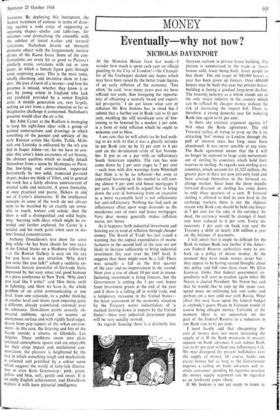Actual aesthete
ART BRYAN ROBERTSON
There's not much around the galleries this week to set your actual aesthete's house on fire, but two independent blazes have been started: one by an English artist in his ripe age, Ben Nicholson, with a coolly immaculate series of inventions at the New London; and one by John Carter, holding his first show at twenty- six with considerable authority at the Redfern Gallery.
Nicholson is keeping up that edgy air of unpredictability established in his last show at the same gallery when a group of weighty and very tough relief paintings, 1966-67, were on view. The new works, oils on cut, asym- metrically shaped paper laid down on toned or textured grounds—and including some fine bare, sharp engravings of Greece and Asia Minor motifs—are all small, but they pack E powerful punch. The admittedly rarefied at• mosphere of Nicholson's present towering summit of achievement is lit up time and agair by some insight or other which goes mud farther than mere device or resourcefulness A case in point is the series of varia Lions on the theme of a pair of black iron hand-ground scissors which, it seems, the artis
treasures. By deploying this instrument, the leanest statement of contour in terms of draw- ing, against a wide range of supporting or opposing shapes—circles and table-tops, for instance—and dramatising the ensemble with the subtlest of tinted washes and textural variations, Nicholson invests an innocent domestic object with the languorously incisive
drama of the Kama Sutra. Some of the con-
frontations are every bit as good as Picasso's similarly erotic variations with cut or torn paper, in which a female figure goes through some surprising paces. This is the most tonic, wholly charming and inventive show in Lon-
don: the jeux d'esprit of a master—and how his
presence is missed, whether they know it or not, by young artists in England who lack any yardstick provided by a senior English artist. A middle generation are, very largely, seeking an exit from a dense situation so far as imaginative challenge is concerned. Nicholson's presence would clear the air a lot.
But John Carter at the Redfern is managing to keep his sight-lines clear with a group of painted constructions and drawings in which something of the passion and sobriety of the early Russian artists like Gabo, Tatlin, Male-
vich and Lissitsky is enlivened by the wit you find in Jasper Johns7--or, for we have to con- sider this artist's keen awareness of art history, the abstract qualities which so readily detach themselves from a scene by Mantegna or. Piero. One low-lying rod construction, supported horizontally by two solid, truncated pyramid shapes, makes me think of Tibet, and in general the work has a fairly obvious undercurrent of oriental calm and restraint. A grave formality, at once practical and poetic, flickers in and out of Carter's discoveries. If the intellectual concepts in some of the work do not always seem to be matched by an exactly apt sensu- ality in touch, texture and colour, then the show is still a distinguished and solid begin- ning: bursting with ideas which might be ex- tended and further explored, for Carter is a serialist and his work gains when seen in dis- tinct formal concentrations.
Anthony Donaldson's first show for some long while—he has been absent for two years in the United States on a Harkness fellowship —at the Rowan Gallery is easy on the eye but you have to pay attention. `Why don't you write like you talk?' asked a suddenly en- thusiastic literary journalist of Gertrude Stein, impressed by her easy sense and good humour at a press conference in New York. `Why don't you read like I write?' said Miss Stein, swift as lightning, and there we have it, the whole problem of an artist communicating at one level, from one rationale, to a public thinking at another level and intent upon imposing quite a different, already assimilated, rationale over its substance. Donaldson paints severely ab- stracted emblems, sprayed to assume an anonymous surface and with rigidly hard edges, drawn from pop aspects of the urban environ- ment—in this case, the lettering and bits of the façade outside a cinema in Glendale, Los Angeles. These emblems zoom into plain coloured atmospheric spaces and are enjoyable for their crisp impact and uncluttered con- centration; the pleasure is heightened by the way in which something tough and mechanistic is softened and prettified by a colour sense which suggests the world of fairy-tale illustra- tion or even Kate Greenaway: pink, green, yellow and blue, soft, -gentle and sweet. It is an oddly English achievement, and Donaldson exploits it with keen pictorial intelligence.















































 Previous page
Previous page